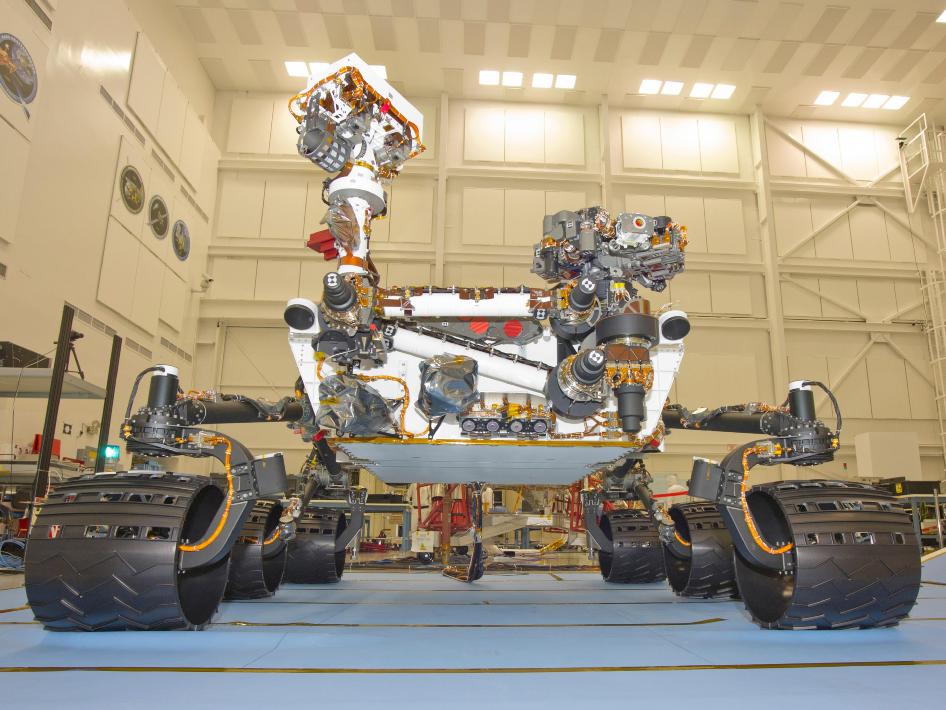NASA's Biggest Mars Rover Yet to Launch This Month

NASA's newest Mars rover, the Mini Cooper-size Curiosity, is just over two weeks away from launching to the Red Planet.
The Curiosity rover is larger, and can travel farther, than any roving vehicle ever sent to Mars. Its goal is to investigate whether our planetary next-door neighbor was ever hospitable to life.
"We have been studying the planet as a whole with our orbiters, and with recent rovers we've been following evidence of water on the surface," said Ashwin Vasavada, the deputy project scientist for Curiosity at NASA's Jet Propulsion Lab in Pasadena, Calif. "This rover is the first to address the next goal, which is to search for habitable environments. We're landing on a place that has the potential to have been habitable in the past, one that could have supported life, and we want to understand whether that actually was the case."
The home stretch
Curiosity, also known as NASA's Mars Science Laboratory, has been under development for seven years. Now, scientists who have devoted years to the project are nearing the home stretch, when they will see the hardware they've designed and built finally lifted off into space. [Mars Explored: Landers and Rovers Since 1971 (Infographic)]
The $2.5 billion rover is slated to launch on an Atlas 5 rocket from Cape Canaveral Air Force Station in Florida. The liftoff is scheduled for Nov. 25 at 10:25 a.m. EST (1725 GMT).
The 1,980-pound (900 kgs) rover has already been shipped to the Cape and packed aboard the rocket.
Breaking space news, the latest updates on rocket launches, skywatching events and more!
"It's a relief," Vasavada told SPACE.com. "It's really a huge milestone for the project. We've handed over the rover and its spacecraft to the launch vehicle people and said goodbye."
After Curiosity launches, it will take about nine months to reach Mars, with an expected landing in August 2012. The spacecraft carrying the rover will descend partway to the surface on a parachute, and then it will act as a "Sky Crane," hovering in the air while gently lowering the rover, attached to tethers, onto the ground.
"I think, psychologically, landing is by far the most difficult part because everything has to go right in about seven minutes," Vasavada said. "The entire future of the mission depends on everything going right in that seven minutes."
The challenge of reaching Mars was highlighted Tuesday (Nov. 8), when Russia's Phobos-Grunt spacecraft failed set course for the Red Planet shortly after launching into space. The Phobos-Grunt mission is an ambitious project to collect samples from the Mars moon Phobos. Russian engineers are working to try and salvage the mission.
Bigger and better
Curiosity is one of NASA's "flagship" missions, its most expensive and ambitious class of spacecraft designed to explore the solar system.
"It's the largest vehicle that’s ever landed on Mars," Vasavada said. "NASA built it with the very highest standards of reliability and quality."
The rover is designed to roll over obstacles up to 29 inches (75 centimeters) high and cover up to 295 feet (90 meters) of ground an hour. It has 10 different science instruments to measure the chemical and geologic properties of the Mars rock samples it collects.
Scientists carefully selected its landing site, Gale Crater, from a list of 60 potential touchdown spots. The 96-mile (154 kilometers) wide crater has a mountain in its center with exposed rock faces representing various different periods from Mars' geologic history.
Yet for all the redundancies built into the machine, watching Curiosity launch and land will be a nail-biter for the scientists who've poured so much work into it.
"Space is still a risky business," Vasavada said. "There are no guarantees in exploring Mars and there are some new technologies on this spacecraft that haven't been used before."
You can follow SPACE.com assistant managing editor Clara Moskowitz on Twitter @ClaraMoskowitz. Follow SPACE.com for the latest in space science and exploration news on Twitter @Spacedotcom and on Facebook.
Join our Space Forums to keep talking space on the latest missions, night sky and more! And if you have a news tip, correction or comment, let us know at: community@space.com.

Clara Moskowitz is a science and space writer who joined the Space.com team in 2008 and served as Assistant Managing Editor from 2011 to 2013. Clara has a bachelor's degree in astronomy and physics from Wesleyan University, and a graduate certificate in science writing from the University of California, Santa Cruz. She covers everything from astronomy to human spaceflight and once aced a NASTAR suborbital spaceflight training program for space missions. Clara is currently Associate Editor of Scientific American. To see her latest project is, follow Clara on Twitter.

